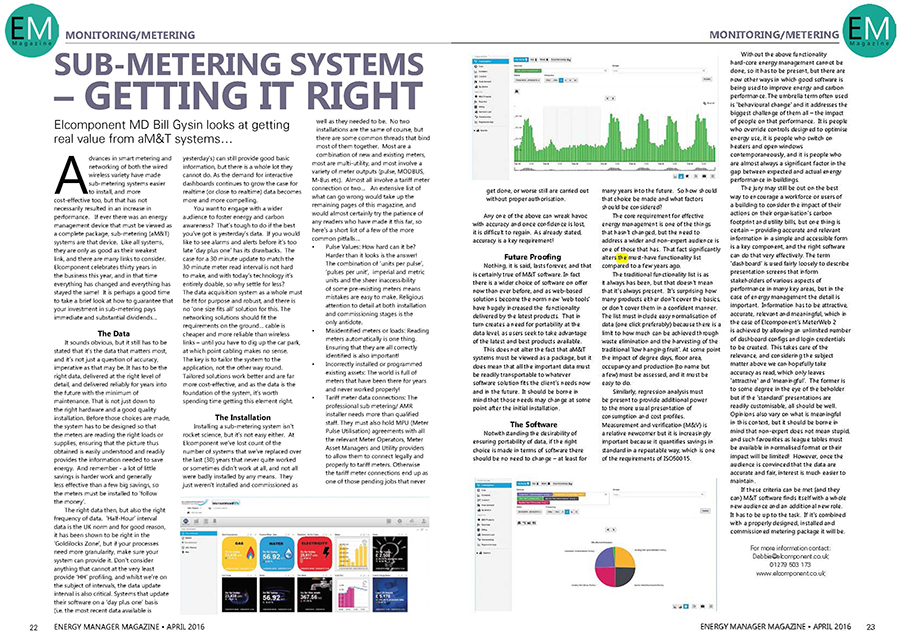
EM Magazine:
Sub-Metering Systems – Getting it Right
Elcomponent MD Bill Gysin looks at getting real value from aM&T systems
Advances in smart metering and networking of both the wired wireless variety have made sub-metering systems easier to install, and more cost-effective too, but that has not necessarily resulted in an increase in performance. If ever there was an energy management device that must be viewed as a complete package, sub-metering (aM&T) systems are that device. Like all systems, they are only as good as their weakest link, and there are many links to consider. Elcomponent celebrates thirty years in the business this year, and in that time everything has changed and everything has stayed the same! It is perhaps a good time to take a brief look at how to guarantee that your investment in sub-metering pays immediate and substantial dividends.
The Data
It sounds obvious, but it still has to be stated that it’s the data that matters most, and it’s not just a question of accuracy, imperative as that may be. It has to be the right data, delivered at the right level of detail, and delivered reliably for years into the future with the minimum of maintenance. That is not just down to the right hardware and a good quality installation. Before those choices are made, the system has to be designed so that the meters are reading the right loads or supplies, ensuring that the picture thus obtained is easily understood and readily provides the information needed to save energy. And remember – a lot of little savings is harder work and generally less effective than a few big savings, so the meters must be installed to follow the money. The right data then, but also the right frequency of data. ‘Half-Hour’ interval data is the UK norm and for good reason, it has been shown to be right in the ‘Goldilocks Zone’, but if your processes need more granularity, make sure your system can provide it. Don’t consider anything that cannot at the very least provide ‘HH’ profiling, and whilst we’re on the subject of intervals, the data update interval is also critical. Systems that update their software on a ‘day plus one’ basis (i.e. the most recent data available is yesterday’s) can still provide good basic information, but there is a whole lot they cannot do. As the demand for interactive dashboards continues to grow the case for realtime (or close to realtime) data becomes more and more compelling. You want to engage with a wider audience to foster energy and carbon awareness? That’s tough to do if the best you’ve got is yesterday’s data. If you would like to see alarms and alerts before it’s too late ‘day plus one’ has its drawbacks. The case for a 30 minute update to match the 30 minute meter read interval is not hard to make, and with today’s technology it’s entirely doable, so why settle for less? The data acquisition system as a whole must be fit for purpose and robust, and there is no ‘one size fits all’ solution for this. The networking solutions should fit the requirements on the ground cable is cheaper and more reliable than wireless links until you have to dig up the car park, at which point cabling makes no sense. The key is to tailor the system to the application, not the other way round. Tailored solutions work better and are far more cost-effective, and as the data is the foundation of the system, it’s worth spending time getting this element right.The Installation
Installing a sub-metering system isn’t rocket science, but it’s not easy either. At Elcomponent we’ve lost count of the number of systems that we’ve replaced over the last (30) years that never quite worked or sometimes didn’t work at all, and not all were badly installed by any means. They just weren’t installed and commissioned as well as they needed to be. No two installations are the same of course, but there are some common threads that bind most of them together. Most are a combination of new and existing meters, most are multi-utility, and most involve a variety of meter outputs (pulse, MODBUS, M-Bus etc). Almost all involve a tariff meter connection or two. An extensive list of what can go wrong would take up the remaining pages of this magazine, and would almost certainly try the patience of any readers who have made it this far, so here’s a short list of a few of the more common pitfalls- Pulse Values: How hard can it be? Harder than it looks is the answer! The combination of ‘units per pulse’, ‘pulses per unit’, imperial and metric units and the sheer inaccessibility of some pre-existing meters means mistakes are easy to make. Religious attention to detail at both installation and commissioning stages is the only antidote.
- Misidentified meters or loads: Reading meters automatically is one thing. Ensuring that they are all correctly identified is also important!
- Incorrectly installed or programmed existing assets: The world is full of meters that have been there for years and never worked properly!
- Tariff meter data connections: The professional sub metering/ AMR installer needs more than qualified staff. They must also hold MPU (Meter Pulse Utilisation) agreements with all the relevant Meter Operators, Meter Asset Managers and Utility providers to allow them to connect legally and properly to tariff meters. Otherwise the tariff meter connections end up as one of those pending jobs that never get done, or worse still are carried out without proper authorisation.
